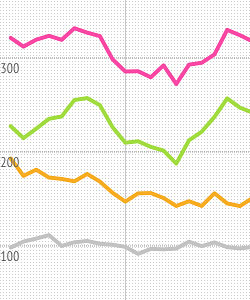The year-end real-estate data has been rolling in for the past week or so, and much of it is encouraging. But there’s something that bugs me—and, I believe, a lot of sellers or potential sellers. But first, the good news:
On Tuesday, the Illinois Association of Realtors reported that the city, the region, and the state all did better in 2012 than in 2011 on both the number of properties sold and the median sales price. (Chicago condo prices were the only ones to fall, by 3.1 percent.)
I prepared the chart at right using data from Midwest Real Estate Data (MRED), the Chicago region’s multiple-listing service. It indicates average sale price of homes by type of sale from January 2011 to December 2012. (The numbers on the vertical axis represent $thousands.) As you can see, even though foreclosure prices have remained relatively flat (gray) and short sale prices (orange) have been dropping, the prices of nondistressed homes (the top—pink—line) climbed through the fall and early winter (The green line is for all three types of sales combined).
Also on Monday, MRED reported that the amount of inventory on the market at the close of the year was about half what it had been at the end of 2010. That’s similar to a report issued last week by Estately, which said that Chicago-area listings on January 1 were about two-thirds what they had been at the beginning of 2012.
Less inventory means that buyers trying to take advantage of low prices and low interest rates have “less to choose from, so they’ll bid harder on what’s there,” said Russ Bergeron, MRED’s CEO. That nudges sale prices upward.
MRED’s year-end data, released Monday, showed that properties are selling far faster now. Foreclosures were selling 21 percent faster in December than at their slowest point during the year, and short sales were selling 18 percent faster. Time on the market for traditional, or nondistressed, homes dropped by 27 percent—from February, their slowest month—to an average time on the market of 142 days.
Good news, all of it, for buyers—and for sellers who can afford to sell.
And that’s the problem: selling is very costly now. Even with recent price gains, most homes in the Chicago area are still worth about 25 percent less than they were in mid-2006, before the housing bust. This is why, as Zillow reported Monday, 48.6 percent of Chicago-area sellers sold at a loss in December. And that’s just the average for the region; in more than a dozen suburbs, more than 60 percent of sellers lost money in December.
Using historical data from Zillow, I prepared the chart at the top of the page. It shows the percentage of Chicago-area homes that sold at a loss from January 2007 to December 2012. It rises steeply at first—and then just keeps finding new highs.
You don’t have to be underwater, as 25 percent of Illinois homeowners are, to lose money in the deal; you only have to sell for less than you paid for the home.
And that, I believe, is a key reason our inventory is so low. Homeowners have seen many of their neighbors and friends lose money in their deals, and so they opt not even to try selling unless they really need to move. “People are figuring, ‘Heck, I’ve lost so much value, I can’t afford to lose all that money,’ ” Bergeron says. “ ‘Maybe I’ll just hold on to this house.’ ”
We’re not the only ones arguing that potential sellers are frightened of being the housing market’s losers. On Tuesday, Nick Timiraos of the Wall Street Journal listed sellers’ weak position as among the main reasons housing inventory is declining.
As the Zillow data show, selling at a loss is the new black: it’s everywhere. And at some point, when it becomes too familiar, people even rebel against wearing black.




